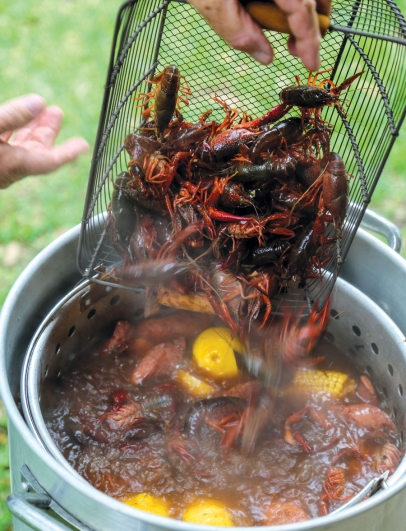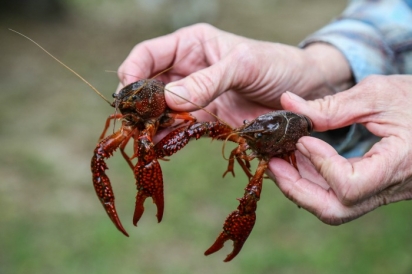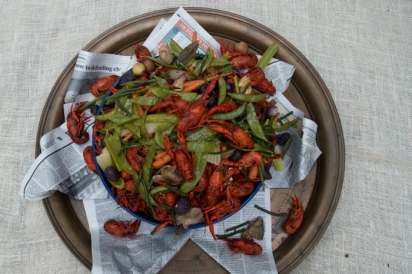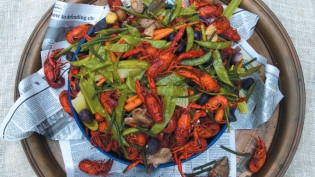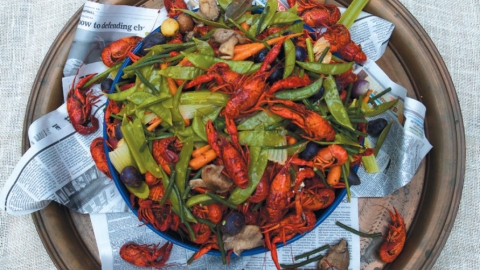Boil on the Bayou: Houston's New Backyard Meal
Houston’s love affair with the crawfish boil shows no sign of cooling down
Before the Trinity River Authority created Lake Livingston by strangling the river about 70 miles northeast of Houston, the river rose and fell on its own natural rhythms. As the spring rains saturated the floodplains, millions of crawfish—“mudbugs,” in the common vernacular—crawled upward through the softening mud, stirred from sluggish aestivation (a near-hibernative state) by the primeval urge to feed and mate.
My husband was in his teens then, and his family lived near the lower end of the Trinity, where the river empties into Trinity Bay at the upper reaches of Galveston Bay. Shannon’s daddy would hand him the keys to his ’66 Chevy pickup, and he and his brother Ricky would “light a shuck” for the muddy, swollen river, with a half-dozen No. 3 washtubs—each capable of holding 17 gallons—clattering in the truck’s wooden bed. At the river, the teenagers would drag and pull the heavy 20-foot seine through the swirling swamp gumbo again and again, bringing up roiling masses of huge “swamp reds” with each pull. Into the washtubs went the mudbugs, the boys pitching out the occasional snake, fish or frog before pulling the seine again.
Once the washtubs were full, they’d hightail them home to drop their catch and while their parents boiled bugs and shelled out the sweet tail meat, the boys would set out on another 20-mile round trip to the river. Round and round they’d go, until the home freezer was crammed with crawfish tails and everyone was bone-tired.
When Lake Livingston filled behind the Livingston Dam in 1971, its chokehold tamed the mighty river’s hydrology forever ... and the crawfish, sadly, have all but disappeared. Although Texas does produce some farm-raised crawfish, Louisiana leads all states in crawfish production, with the highest concentration of crawfish farms being in the Atchafalaya Basin. In 2014, the most recent year for which Louisiana State University has compiled data, the tally came to 15 million pounds of wild-caught crawfish and 127 million pounds of farm-raised ones. Louisiana “swamp reds” reign as the most highly prized of all.
My favorite place to buy my swamp reds? Boyd’s One Stop in Texas City.
I scan the swarming parking lot at Boyd’s for an open spot: Although it’s mid-morning on a Wednesday, cars and trucks—some with trailered fishing boats—fill every parking space and rim the shoulders of Dike Road. Customers queue up around the front of the restaurant, even though it’s well ahead of lunchtime, spilling down the sidewalk and past the retail shop, stepping aside every few minutes to allow streams of Texas City Dike anglers in or out of the store. From another doorway to the right, employees heave out 30-pound sacks into the arms of waiting customers. From the sacks come a crackling, crinkly sound like the bursting of thousands of champagne bubbles … the sound of thousands of tiny pincers clicking against chitin.
In those sacks? Crawfish, i.e., mudbugs. Prized Louisiana “swamp reds.” And although chitin, a natural form of glucose, comprises these crustaceans’ shells, the real sweetness—the lobster-like sweet tail meat—is inside.
Through the building at the back doorway, I see owner Jason Cogburn carrying bushels of ’bugs to the restaurant kitchen for the midday repast. With his height, build, ice-blue eyes and flowing red beard, he could pass for Ragnar’s kid brother on the History Channel’s hit show “Vikings.” “I bought Boyd’s One Stop in 1999, and expected it would continue as it always had been: as the bait shop serving the needs of the anglers fishing the Texas City Dike,” he tells me, “specializing in live bait … you know, croaker, mullet, mudfish, piggy perch. Ike changed that.”
The “Ike” Cogburn refers to is Hurricane Ike, the third-most-destructive storm to hit the US, which in 2008 sent an 11-foot storm surge over the Texas City Dike, rendering it useless and inaccessible for two years. No dike, no dike fishermen. No dike fishermen, no need for a live bait shop. Cogburn’s business could have easily been washed away with the detritus and debris, but he determined to change his focus and try to survive.
“Growing my seafood business was my only option to stay in business,” he continues as he leans forward. “Are you a believer? I really think God had a plan. I’ve done really well with shrimp.” (Actually, better than really well: He’s earned the well-deserved moniker of “The Shrimp King of Texas.”) Shrimp, however, no longer make up the bulk of Boyd’s business: The saltwater delicacy has been dethroned by the lowly mudbug.
Cogburn runs his own fleet of trucks back and forth to Louisiana, contracting with crawfish purveyors in both south and north Louisiana. “That way, I get the first crawfish of the season, as the south cranks up first, and then buy from my northern suppliers later to extend my season as long as possible.” He sells not only direct-to-consumer but also to numerous area restaurants and most recently, H-E-B. And business is booming. “In 2005—pre-Ike—I sold 36,000 pounds of crawfish,” Cogburn says. “In 2015, I sold 2.5 million pounds. And 2016 looks to be even better, both from the availability side and from the consumer demand side. In Houston, the backyard barbecue has been replaced by the crawfish boil.”
Go old school with the Cajun-style boil or demonstrate your Asian/ Cajun fusion prowess with a Houston original, the increasingly popular Vietnamese boil: Following is Edible Houston’s signature version, which relies on fresh, seasonal vegetables for a uniquely healthy twist. And remember: They’re called mudbugs for a reason: The first step is to separate the crawfish from any mud they brought with ’em. Release the “bugs” into a large washtub or kiddie pool, fill it with enough water to barely cover them, and agitate the water a bit. Don’t drown ’em; they need to be able to get their heads out of the water to breathe. Drain the water, and repeat the process two to four times, until the water runs clear. Leave about one inch water in the bottom of the tub so they stay hydrated, and dispose of any dead ones.
For either recipe, you will need at least a 30-quart crawfish pot with a strainer insert, a propane burner and propane tank, heat-proof gloves or oven mitts, a broom handle or sturdy stick to lift and drain the strainer, and a large cooler in which to stash the vegetables so they stay hot while the crawfish cook. Set up your pot in an outdoor, draft-free location with access to water, and Laissez les bon temps roulez!


